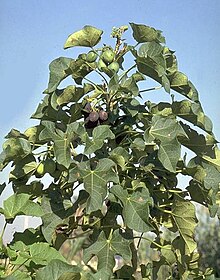| Jatropha curcas | |
|---|---|

| |
| Scientific classification | |
| Kingdom: | Plantae |
| Clade: | Tracheophytes |
| Clade: | Angiosperms |
| Clade: | Eudicots |
| Clade: | Rosids |
| Order: | Malpighiales |
| Family: | Euphorbiaceae |
| Genus: | Jatropha |
| Species: | J. curcas
|
| Binomial name | |
| Jatropha curcas | |
Jatropha curcas is a species of flowering plant in the spurge family, Euphorbiaceae, that is native to the American tropics, most likely Mexico and Central America.[2] It is originally native to the tropical areas of the Americas from Mexico to Argentina, and has been spread throughout the world in tropical and subtropical regions around the world, becoming naturalized or invasive in many areas.[3] The specific epithet, "curcas", was first used by Portuguese doc Garcia de Orta more than 400 years ago.[4] Common names in English include physic nut, Barbados nut, poison nut, bubble bush or purging nut.[3] In parts of Africa and areas in Asia such as India it is often known as "castor oil plant" or "hedge castor oil plant",[3] but it is not the same as the usual castor oil plant, Ricinus communis (they are in the same family but different subfamilies).
J. curcas is a semi-evergreen shrub or small tree, reaching a height of 6 metres (20 feet) or more.[2] It is resistant to a high degree of aridity, allowing it to grow in deserts.[5][6] It contains phorbol esters, which are considered toxic.[7] However, edible (non-toxic) varieties native to Mexico also exist, known by the local population as piñón manso, xuta, chuta, aishte, among others.[8][9] J. curcas also contains compounds such as trypsin inhibitors, phytate, saponins and a type of lectin[10][11] known as curcin.[12]
The seeds contain 27–40% oil[13] (average: 34.4%[14]) that can be processed to produce a high-quality biodiesel fuel, usable in a standard diesel engine.[15] This oil may be also used for thermal energy storage or as heat transfer fluid at medium and high-temperature.[16][17][18] The oil has a very purgative property.[19] Edible (non-toxic) varieties, as those developed by selection by ethnic Mexican natives in Veracruz, can be used for animal feed and food.[20][8]
- ^ "Jatropha curcas". Germplasm Resources Information Network. Agricultural Research Service, United States Department of Agriculture. Retrieved 2010-10-14.
- ^ a b Janick, Jules; Robert E. Paull (2008). The Encyclopedia of Fruit & Nuts. CABI. pp. 371–372. ISBN 978-0-85199-638-7.
- ^ a b c "Jatropha curcas (jatropha)". Cabi.org.
- ^ "Site off-line | Drupal" (PDF). Apps.worldagroforestry.org. Retrieved 9 April 2022.
- ^ "JATROPHA IN AFRICA. FIGHTING THE DESERT & CREATING WEALTH". Archived from the original on 2008-06-13.
- ^ "New Agriculturist: Focus on... Jatropha: creating desert solutions". New-ag.info. Archived from the original on 2009-12-08. Retrieved 2008-06-12.
- ^ Goel, Gunjan; Makkar, Harinder P. S.; Francis, George; Becker, Klaus (30 November 2016). "Phorbol Esters: Structure, Biological Activity, and Toxicity in Animals". International Journal of Toxicology. 26 (4): 279–288. CiteSeerX 10.1.1.320.6537. doi:10.1080/10915810701464641. PMID 17661218. S2CID 11550625.
- ^ a b Martínez-Herrera, J., Martínez Ayala, A., Makkar, H.P.S., Francis, G., Becker, K. 2010. Agroclimatic conditions, chemical and nutritional characterization of different provenances of Jatropha curcas L. from Mexico. Journal of Food Quality 35:152-158.
- ^ Valdes-Rodríguez, O.A., Sánchez-Sánchez, O., Pérez-Vazquez, A., Caplan, J. 2013. The Mexican non-toxic Jatropha curcas L., food resource or biofuel? Ethnobotany Research and Applications 11: 001-007
- ^ Makkar, H.P.S., Francis, G., Becker, K. 2008. Protein concentrate from Jatropha curcas screw-pressed seed cake and toxic and antinutritional factors in protein concentrate. Journal of Science of Food and Agriculture 88: 1542-1548.
- ^ Martínez-Herrera, J., Jiménez-Martínez, C., Martínez Ayala, A., Garduño-Siciliano, L., Mora-Escobedo, R., Dávila-Ortiz, G., Chamorro-Cevallos, G., Makkar, H.P.S., Francis, G., Becker, K. 2012. Evaluation of the nutritional quality of non-toxic kernel flour from Jatropha curcas L. in rats. Journal of Food Quality 35:152-158.
- ^ Lin, J., Zhou, X., Wang, J., Jiang, P., Tang, K. 2010. Purification and characterization of curcin, a toxic lectin from the seed of Jatropha curcas. Preparative Biochemistry and Biotechnology, 40 (2): 107-118. DOI: 10.1080/10826060903558588
- ^ Achten WMJ, Mathijs E, Verchot L, Singh VP, Aerts R, Muys B 2007. Jatropha biodiesel fueling sustainability?. Biofuels, Bioproducts and Biorefining 1(4), 283-291.[1] doi:10.1002/bbb.39The Jatropha Archives
- ^ Achten WMJ, Verchot L, Franken YJ, Mathijs E, Singh VP, Aerts R, Muys B 2008. Jatropha bio-diesel production and use. (a literature review) Biomass and Bioenergy 32(12), 1063–1084.[2] doi:10.1016/j.biombioe.2008.03.003The Jatropha Archives
- ^ Costa, Gustavo GL; Cardoso, Kiara C.; Del Bem, Luiz EV; Lima, Aline C.; Cunha, Muciana AS; de Campos-Leite, Luciana; Vicentini, Renato; Papes, Fábio; Moreira, Raquel C.; Yunes, José A.; Campos, Francisco AP (2010-08-06). "Transcriptome analysis of the oil-rich seed of the bioenergy crop Jatropha curcas L". BMC Genomics. 11 (1): 462. doi:10.1186/1471-2164-11-462. ISSN 1471-2164. PMC 3091658. PMID 20691070.
- ^ Kenda, Eric Serge; N’Tsoukpoe, Kokouvi Edem; Ouédraogo, Igor W. K.; Coulibaly, Yézouma; Py, Xavier; Ouédraogo, Fabrice Marie Armel W. (2017-10-01). "Jatropha curcas crude oil as heat transfer fluid or thermal energy storage material for concentrating solar power plants". Energy for Sustainable Development. 40: 59–67. doi:10.1016/j.esd.2017.07.003. ISSN 0973-0826.
- ^ Gomna, Aboubakar; N’Tsoukpoe, Kokouvi Edem; Le Pierrès, Nolwenn; Coulibaly, Yézouma (2020-04-15). "Thermal stability of a vegetable oil-based thermal fluid at high temperature". African Journal of Science, Technology, Innovation and Development. 12 (3): 317–326. doi:10.1080/20421338.2020.1732080. ISSN 2042-1338.
- ^ N’Tsoukpoe, Kokouvi Edem; Le Pierrès, Nolwenn; Seshie, Yao Manu; Coulibaly, Yézouma (2021-02-23). "Technico-economic comparison of heat transfer fluids or thermal energy storage materials: A case study using Jatropha curcas oil". African Journal of Science, Technology, Innovation and Development. 13 (2): 193–211. doi:10.1080/20421338.2020.1838082. ISSN 2042-1338.
- ^ The Complete Guide to Edible Wild Plants. United States Department of the Army. New York: Skyhorse Publishing. 2009. p. 135. ISBN 978-1-60239-692-0. OCLC 277203364.
{{cite book}}: CS1 maint: others (link) - ^ Francis, G., Oliver, J., Sujatha, M. 2013. Non-toxic jatropha plants as a potential multipurpose multi-use oilseed crop. Industrial Crops and Products 42: 397-401.